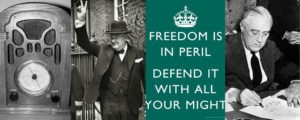New Tricks, Old Dog: World War II Communications
Posted At: June 5, 2013 1:40 P.M.
by Gillian Richard
Communication is constantly changing. With each new step, it appears that we leave our old ways behind. Effective communicators should never forget to look backward, however, because there are lessons to be learned from the past.
During wartime or crisis, communication strategies must be changed to fit the situation. These changes can be reflected in the media used, in the messages conveyed and in leadership styles. During World War II, the Americans and the British both had effective communication strategies and exemplary leaders, and PR professionals today can learn from their examples.
Early history
Prior to WWII, the American government used posters to communicate during wartime. Dr. Karla Gower, a professor in The University of Alabama’s Department of Advertising & Public Relations, said that these campaigns saw lots of success.
“The posters riled up public sentiment by painting Germany as the enemy and America as the baby, the white lady of liberty. People became anti-German,” Gower said.
This kind of propaganda can be good, but it can also have an adverse impact. Audiences need to know the whole story, not just its favorable parts.
“WWI posters are cautionary tales. You need to be careful using things that play to emotions instead of rational thought,” Gower said. “PR deals with persuasion, but it crosses the line into propaganda when you aren’t telling everyone the whole truth.”
The golden ages
The field of communications changed after WWI with the introduction of the radio. Before the Internet and TV, the golden age of radio swept the world. People tuned in to hear their favorite programs, music and news. Radio revolutionized warfare and communications about the war. Radio was effective because of its “incredible penetration,” said Anthony Rudel, author of the book “Hello, Everybody! The Dawn of American Radio.”
President Franklin Roosevelt routinely included radio in his communication strategy. He came into office during a hard time in America’s history, the Great Depression, and used radio as a way to establish his credibility. This credibility lent itself well to his efforts during WWII. He started a successful radio campaign called the fireside chats.
“He used them [fireside chats] in WWII because he had already established that credibility during peacetime, so it was a natural thing,” said Gower.
Because FDR had already built a relationship with his key publics, he was able to keep a good thing going and to bring a sense of reassurance to the American people.
Dr. Diana Martinelli, Widmeyer Professor in Public Relations and associate dean at West Virginia University, said, “The fireside chat national radio broadcasts allowed FDR to reach the nation with the same message, crafted by him and his staff, without interpretation or gatekeeping from the press. In other words, he could deliver the exact message to his audience in a direct, modern and compelling way.”
The other side of the pond
Strong leaders existed in England during the war, as well. In addition to the radio, the British government used a different medium: posters. The popular poster stating “Keep Calm and Carry On” was one of a three-part poster series. It was actually never released during the war, but became popular in later years. According to said Tom Watson, professor of public relations of Bournemouth University, the third poster that has become so popular today was to be used in case the Germans invaded England.
The first two posters that were released stated, “Your courage, your cheerfulness, your resolution will bring us  victory,” and “Freedom is in peril, defend it with all your might.” The common theme of the poster series was that the British people had a role to play in defending their country, even if that role was as simple as keeping calm.
victory,” and “Freedom is in peril, defend it with all your might.” The common theme of the poster series was that the British people had a role to play in defending their country, even if that role was as simple as keeping calm.
Rudel said that the British used radio as both an offensive and defensive tool throughout the course of the war, but the government made its presence known in other ways.
“[Winston] Churchill became the symbol of British resistance through his leadership and his ability to embody all that was British in his speeches,” said Dr. Watson. “Like the King, Churchill toured the country throughout the war and was very visible to his countrymen and women.”
Dr. Gower said this personal connection made a difference during the war. “British people saw their royalty out and doing things and not hiding in a castle somewhere,” she noted.
During hard times, people look to the influence of strong leaders, and how those leaders communicate is crucial to the success of their communication campaigns. The power and influence of good leaders should never be overlooked as a part of an effective communication strategy in wartime or in peace.




